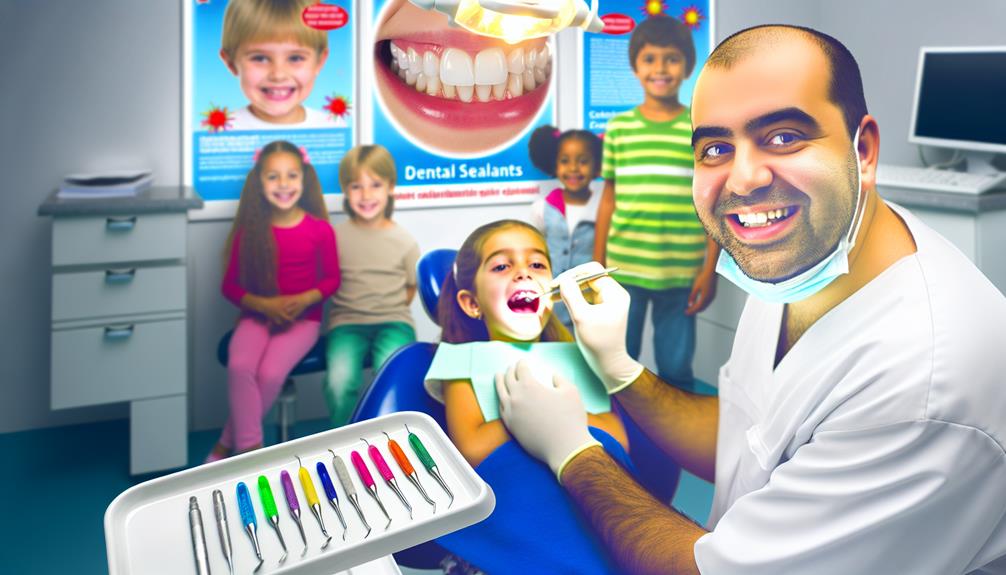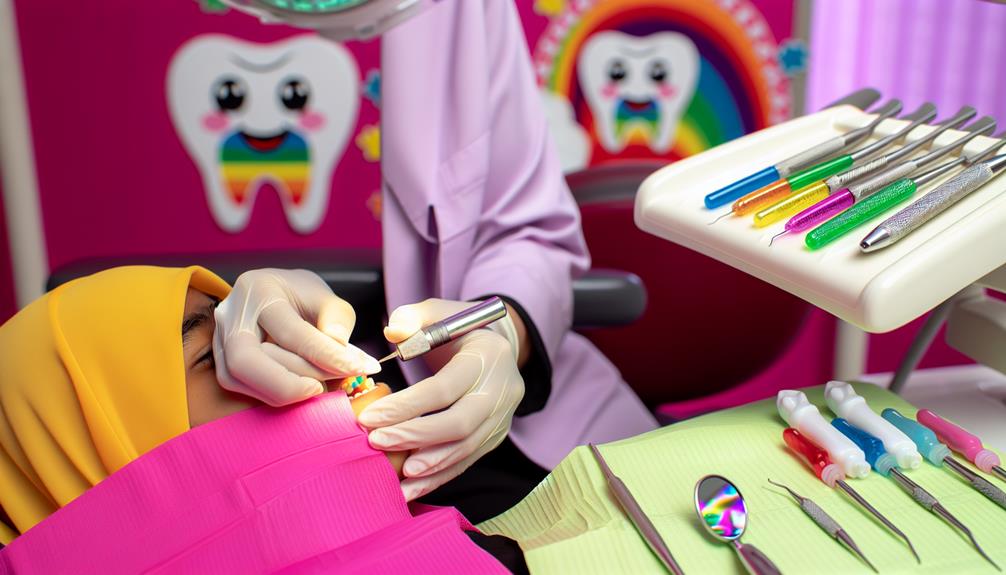Dental sealants are thin, protective coatings applied to molars and premolars, serving as an effective barrier against bacteria and food particles. They greatly reduce the risk of cavities, especially in children, and promote better oral hygiene. The costs of sealants vary based on materials and geographic location, but they often offer long-term savings by preventing expensive dental treatments later. Many insurance plans cover sealants, especially for children, usually ranging from 50-100%. Consult your provider for specific coverage details. Exploring further can provide deeper insights into the application process and maintenance of sealants.
Key Takeaways
- Dental sealants provide an effective barrier against cavities, significantly reducing the risk of decay in molars and premolars.
- The cost of sealants varies based on material quality, application complexity, and geographic location, but they offer long-term savings.
- Many dental insurance plans cover sealants, typically ranging from 50-100% for children, and varying coverage for adults.
- The application process is quick, painless, and suitable for all ages, making it a valuable preventive measure.
- Regular dental visits and proper oral hygiene are essential for maintaining the effectiveness of dental sealants over time.
What Are Dental Sealants?

Understanding dental sealants involves recognizing their role in preventive dentistry and how they can contribute to overall health. Dental sealants are thin, protective coatings applied to the chewing surfaces of molars and premolars, where cavities are most likely to develop. These sealants primarily consist of resin-based sealant materials that bond to the tooth enamel, creating a smooth surface that is easier to clean. By preventing decay, they can reduce the need for more invasive dental treatments in the future, which is essential for maintaining both oral and emotional well-being during challenging times, as navigating grief can impact a person's overall health.
The application process for dental sealants is straightforward and typically completed during a routine dental visit. Initially, the dentist will clean the tooth surface thoroughly to remove any plaque and debris. After drying the tooth, an acidic solution is applied briefly to help the sealant adhere better. Once rinsed and dried, the sealant material is painted onto the tooth, filling in the grooves and fissures. A special light may be used to cure the sealant, ensuring it hardens effectively.
Dental sealants serve as a barrier against food particles and bacteria, greatly reducing the risk of decay. By understanding what dental sealants are and how they are applied, individuals can make informed decisions about their oral health and work collaboratively with their dental care providers towards achieving ideal dental hygiene.
Key Benefits of Dental Sealants
Dental sealants offer several key benefits that greatly enhance oral health, particularly in the prevention of cavities. These protective coatings are applied to the chewing surfaces of molars, where food particles and bacteria often accumulate, leading to tooth decay. The sealant application effectively creates a barrier that seals off these vulnerable areas, markedly reducing the risk of cavities. Furthermore, maintaining good oral health can contribute to overall well-being, as stress has been shown to weaken the immune system, increasing vulnerability to various health issues how stress affects immunity.
One of the primary advantages of dental sealants is their cost-effectiveness in cavity prevention. By preventing decay before it starts, sealants can help individuals avoid more extensive and expensive dental treatments in the future. Additionally, sealants are quick and painless to apply, making them an ideal option for children and adults alike.
In addition, studies have shown that children with dental sealants experience a considerably lower incidence of cavities compared to those without them. This protective measure not only promotes better oral health but also aids in fostering a sense of community belonging, as families can work together to guarantee their loved ones maintain a healthy smile. Overall, dental sealants serve as a valuable tool in enhancing oral health and preventing future dental issues.
Understanding the Costs

Many individuals and families may wonder about the financial implications of dental sealants, particularly when evaluating their preventive benefits. Understanding the costs associated with dental sealants can help in making informed decisions about oral health. During this process, it's important to remain positive and proactive, similar to managing job changes, as both can feel overwhelming at times. steering through the emotional journey can help ease the stress of financial decisions.
Here are three key factors that influence the overall cost of dental sealants:
- Sealant Materials: The type of sealant used can affect pricing. High-quality resin-based materials may be more expensive but offer better durability and protection.
- Application Techniques: The complexity of the application process can also impact costs. Techniques requiring additional time or specialized equipment could result in higher fees.
- Geographic Location: Prices for dental services, including sealants, can vary greatly based on where you live. Urban areas may have higher costs compared to rural settings.
In addition to these factors, it's important to evaluate the long-term savings associated with preventing cavities through the use of dental sealants. By investing in sealants, families can potentially reduce future dental expenses, making it a financially sound choice for maintaining oral health.
Insurance Coverage Options
Steering through insurance coverage options for dental sealants can greatly influence the overall affordability of this preventive treatment. Understanding different insurance types and their coverage limits is vital in making informed decisions. Many dental insurance plans view sealants as a preventive measure, which often means they may cover a significant portion of the cost.
Here's a breakdown of common insurance types and their respective coverage limits for dental sealants:
| Insurance Type | Typical Coverage Limits |
|---|---|
| Employer-Sponsored Plans | 50-100% coverage for children |
| Medicaid | Varies by state; often covers children |
| Individual Dental Plans | 20-80% coverage, depending on the plan |
It's important to review your specific policy details, as coverage limits can vary widely. Additionally, some plans may have age restrictions or frequency limitations on sealant applications. By understanding your insurance options, you can take proactive steps towards maintaining ideal oral health while minimizing out-of-pocket expenses. Always consult with your insurance provider to clarify your coverage and confirm you are maximizing your benefits.
How to Get Dental Sealants

Obtaining dental sealants is a straightforward process that typically involves a visit to a dental professional. This preventive measure plays an essential role in maintaining dental hygiene, particularly for children and those at higher risk for cavities. Here's how to get started:
- Schedule a Consultation: Contact your dentist to discuss the need for sealants. They will evaluate your dental health and determine if you or your child are suitable candidates.
- Understand the Application Process: During the appointment, the dentist will clean the teeth thoroughly and apply an acid solution to create a rough surface for better adhesion. After rinsing and drying, the sealant material is applied and hardened using a special light.
- Maintain Regular Dental Visits: Follow up with your dentist for regular check-ups to guarantee the sealants remain effective and your dental hygiene practices are on track.
Frequently Asked Questions
Can Adults Benefit From Dental Sealants as Well?
Yes, adults can certainly benefit from dental sealants, which are primarily designed to protect the chewing surfaces of teeth from decay. While commonly utilized in pediatric dentistry, sealant effectiveness extends to adult oral health as well, particularly for those with deep grooves or a history of cavities. Applying sealants can serve as a preventive measure, enhancing overall dental wellness and reducing the risk of future oral health issues in adults.
How Long Do Dental Sealants Typically Last?
Dental sealants typically last between five to ten years, depending on factors such as oral hygiene practices and diet. To guarantee ideal sealant longevity, regular dental check-ups and preventive care are essential. Additionally, maintaining good oral hygiene through brushing and flossing can enhance the durability of sealants. If wear or damage is detected, prompt consultation with a dental professional can facilitate timely maintenance or replacement, guaranteeing continued protection against cavities.
Are There Any Side Effects of Dental Sealants?
While dental sealants are generally safe, some individuals may experience minor side effects. These can include temporary sensitivity to temperature changes or discomfort during the application process. Sealant effectiveness is maintained when applied correctly, minimizing the risk of adverse reactions. It is crucial to consult with a dental professional to guarantee proper application and address any concerns, securing a positive experience and ideal protection for your teeth.
How Are Dental Sealants Applied in Children?
The application process of dental sealants in children involves several straightforward steps. First, the teeth are cleaned and dried to guarantee proper adhesion. Next, a special gel is applied to the tooth surfaces, which helps the sealant bond effectively. After rinsing the gel, the sealant material is painted onto the grooves of the teeth, then cured with a light to harden it. This preventive measure considerably enhances children's dental health by protecting against cavities.
Can Sealants Be Reapplied if They Wear Down?
Yes, dental sealants can indeed be reapplied if they wear down due to normal wear and tear or other factors. Sealant maintenance is essential for ensuring their effectiveness in protecting teeth from decay. The reapplication frequency typically depends on the individual's oral hygiene practices and dietary habits. Regular dental check-ups will help determine when a reapplication is necessary, thereby providing continued protection for the teeth, particularly in children and adolescents.





